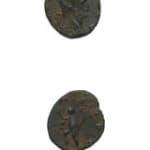Bronze Antoninianus of Emperor Gallienus, 253 CE - 268 CE
Bronze
C.4314
Obverse: GALLIENVS AVG; Radiate and Cuirassed Bust of the Emperor Facing Righ Reverse: ORIENS AVG; Radiate Sol Standing to the Left, Saluting with one Hand and Holding a Palm Frond...
Obverse: GALLIENVS AVG; Radiate and Cuirassed Bust of the Emperor Facing Righ
Reverse: ORIENS AVG; Radiate Sol Standing to the Left, Saluting with one Hand and Holding a Palm Frond and a Whip in the Other
Publius Licinius Egnatius Gallienus was born in Milan in 218 A.D., son of Emperor Valerian. He was raised to the level of co-Augustus soon after his father’s ascension in 253 A.D. The time of his reign was a chaotic era of great political and economic upheaval known as the crisis of the Third Century. The Persian army under King Shapur I defeated the Romans and seized Valerian. This humiliating defeat of the mighty Romans emboldened the Germans to step up their invasions into Roman territory. Meanwhile, the governor of Pannonia, encouraged by the legions, revolted. Gallienus rushed to the scene with his newly created cavalry corps and crushed the insurrection. However, more ominous, was the secession of Gaul, Spain, and Britain under the leadership of Postumus, the legate of the Rhine armies that lasted for two decades. Gallienus reacted swiftly to this threat and defeated Postumus in two battles, but he was unable to deliver a fatal blow to the usurper. Gallienus was wounded in battle in 263 A.D. and retreated to Rome where he recovered during a time of relative peace, known as the “Gallienic Renaissance,” which saw the flowering of the neo-platonic movement. This short period of peace ended in 266 A.D. when the Germans invaded, initiating what would become the bloodiest battle of the century, the Battle of Naissus. Gallienus would meet his end in a coup organized by his staff officers and the commander of the cavalry corps while besieging his hometown of Milan which had seceded under Aureolus, who was allied with Postumus.
How many hands have touched a coin in your pocket or purse? What eras and lands have the coin traversed on its journey into our possession? As we reach into our pockets to pull out some change, we rarely hesitate to think of who might have touched the coin before us, or where the coin will venture to after it leaves our hands. More than money, coins are a symbol of the state that struck them, of a specific time and location, whether contemporary currencies or artifacts of a long forgotten empire. This stunning hand-struck coin reveals an expertise of craftsmanship and intricate sculptural detail that is often lacking in contemporary machine-made currencies. This ancient coin is a memorial to Gallienus, passed from the hands of civilization to civilization, from generation to generation that still appears as vibrant today as the day it was struck.
Reverse: ORIENS AVG; Radiate Sol Standing to the Left, Saluting with one Hand and Holding a Palm Frond and a Whip in the Other
Publius Licinius Egnatius Gallienus was born in Milan in 218 A.D., son of Emperor Valerian. He was raised to the level of co-Augustus soon after his father’s ascension in 253 A.D. The time of his reign was a chaotic era of great political and economic upheaval known as the crisis of the Third Century. The Persian army under King Shapur I defeated the Romans and seized Valerian. This humiliating defeat of the mighty Romans emboldened the Germans to step up their invasions into Roman territory. Meanwhile, the governor of Pannonia, encouraged by the legions, revolted. Gallienus rushed to the scene with his newly created cavalry corps and crushed the insurrection. However, more ominous, was the secession of Gaul, Spain, and Britain under the leadership of Postumus, the legate of the Rhine armies that lasted for two decades. Gallienus reacted swiftly to this threat and defeated Postumus in two battles, but he was unable to deliver a fatal blow to the usurper. Gallienus was wounded in battle in 263 A.D. and retreated to Rome where he recovered during a time of relative peace, known as the “Gallienic Renaissance,” which saw the flowering of the neo-platonic movement. This short period of peace ended in 266 A.D. when the Germans invaded, initiating what would become the bloodiest battle of the century, the Battle of Naissus. Gallienus would meet his end in a coup organized by his staff officers and the commander of the cavalry corps while besieging his hometown of Milan which had seceded under Aureolus, who was allied with Postumus.
How many hands have touched a coin in your pocket or purse? What eras and lands have the coin traversed on its journey into our possession? As we reach into our pockets to pull out some change, we rarely hesitate to think of who might have touched the coin before us, or where the coin will venture to after it leaves our hands. More than money, coins are a symbol of the state that struck them, of a specific time and location, whether contemporary currencies or artifacts of a long forgotten empire. This stunning hand-struck coin reveals an expertise of craftsmanship and intricate sculptural detail that is often lacking in contemporary machine-made currencies. This ancient coin is a memorial to Gallienus, passed from the hands of civilization to civilization, from generation to generation that still appears as vibrant today as the day it was struck.



